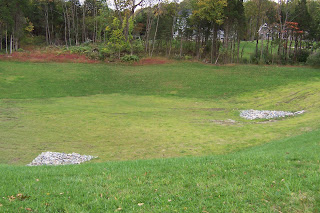Pinky Winky™ Hydrangea in Fall
For those interested in following my Pinky Winky™ Hydrangea field trials (see earlier post at http://loisdevries.blogspot.com/2008/08/pinky-winky-hydrangea.html), here is an update. Those planted in part sun in Spring 2007 are now over five feet tall, even though they were “trimmed” by a doe that had gotten inside our exclosure last summer. She had consumed a huge number of leaves, as well as the flowers and some stems, so I wasn’t terribly optimistic about what I might get this year. But the plants thrived, with no evidence of the “bonsai effect” that deer browse can cause. The flowers begin to emerge in July and last until hard frost.
The blooms shown here were cut on October 30th 2009. We’ve already had one wet, heavy snow earlier in the month, with temperatures dropping into the 30’s, and peaking in the high 60’s. I love how the leaf color has changed from its deep, uniform green to a black-green with red accents, although most have turned yellow now. While the bloom color hasn’t changed that much, it has deepened quite a bit and the light pink racemes now sport flecks of darker rose.
For comparison, I’ve included a shot of the pure-white blossoms as they look when they first emerge. I’m curious to see how the dried flowers will look.
As for the two plants I put in shade, the jury is still out. Those shrubs were planted in Fall 2007, a full growing season behind the others. They developed a sprawling habit and are about four feet wide and two and one-half feet high, but this turned out to be attractive and useful in the particular spot I planted them. They surprised me with unexpected, though sparse white blooms (their spot is very shady) that didn’t last as long as those in sun. Their color turned out to be a plus, since they are adjacent to my White Garden.
All in all, I’d say Pinky Winky™ is a more versatile plant than I expected and, once a gardener understands how it reacts under a variety of conditions, can be used to achieve multiple effects.
The blooms shown here were cut on October 30th 2009. We’ve already had one wet, heavy snow earlier in the month, with temperatures dropping into the 30’s, and peaking in the high 60’s. I love how the leaf color has changed from its deep, uniform green to a black-green with red accents, although most have turned yellow now. While the bloom color hasn’t changed that much, it has deepened quite a bit and the light pink racemes now sport flecks of darker rose.
For comparison, I’ve included a shot of the pure-white blossoms as they look when they first emerge. I’m curious to see how the dried flowers will look.
As for the two plants I put in shade, the jury is still out. Those shrubs were planted in Fall 2007, a full growing season behind the others. They developed a sprawling habit and are about four feet wide and two and one-half feet high, but this turned out to be attractive and useful in the particular spot I planted them. They surprised me with unexpected, though sparse white blooms (their spot is very shady) that didn’t last as long as those in sun. Their color turned out to be a plus, since they are adjacent to my White Garden.
All in all, I’d say Pinky Winky™ is a more versatile plant than I expected and, once a gardener understands how it reacts under a variety of conditions, can be used to achieve multiple effects.



